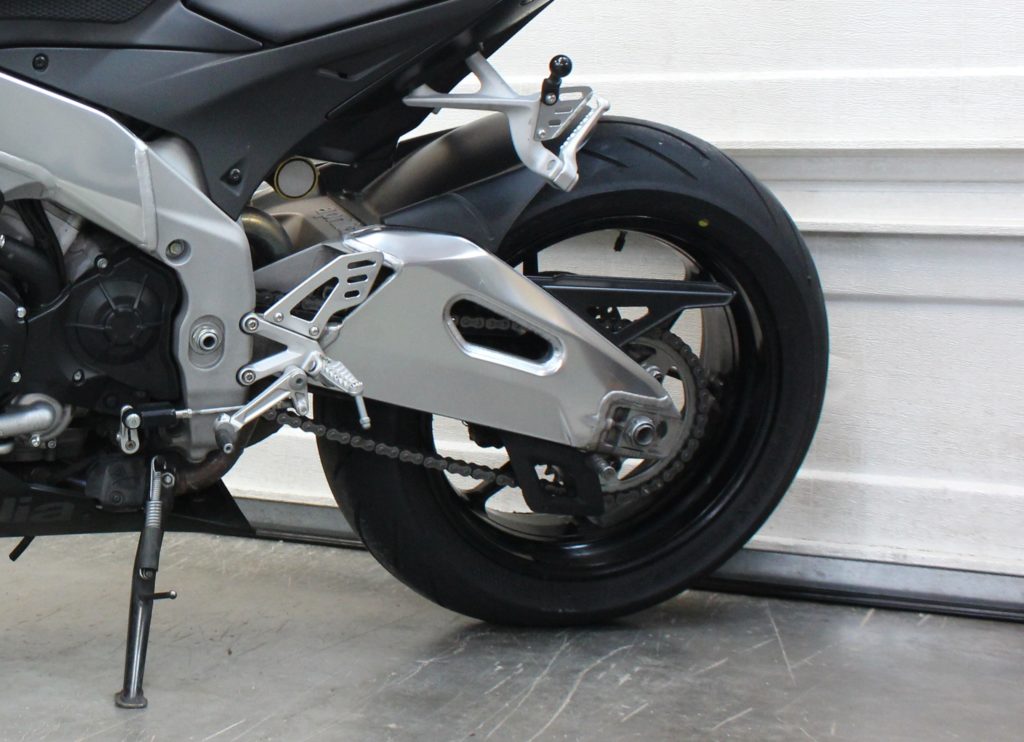Readers Write: Questions on Pirelli Tires and your Chain and Sprockets.

Hi John, Here’s one for you. Other than being stickier, can you explain the differences between DOT track tires and street tires? Since switching from Pirelli Dragons to Pirelli Corsa III’s, I notice that the Corsa III’s are less sensitive to suspension tweaks than the Dragons. With the Dragons, I could feel a slight difference of some sort every time I would make a change to my suspension. With the Corsa’s, I have to make a much more drastic change (i.e. double or triple the turns, mostly preload) in order to get a subtle change in feeling. I should add that I also went to a 190/50 rear instead of a 180/55. Ian
Hi Ian, Thanks for the note. You are right; typically a DOT race tire is first and foremost a high performance tire that prioritizes ultimate grip and rider feedback over life and comfort. The Corsa is a street biased tire that has a slightly softer carcass that absorbs small pavement imperfections much better than the stiffer race carcass Dragon. On the track, when the rider feels each little imperfection in the track surface, they gain confidence in what the front tire is doing and they feel much safer pushing the tire to it’s (or their) limit. When an overly soft carcass is used, the carcass absorbs all the small bumps which is great on the street, but on the track the rider is left with a numb sensation from the tire which clouds the grey area where the tire can provide ultimate traction. In other words they don’t know where the limit is because they aren’t picking up any track ‘noise’ from the tire. Back a few years ago when the Canadian Superbike Series switched to Pirelli as a spec tire, this was the biggest hurdle to overcome. All the top riders had ‘grown up’ as it were on Dunlops, which have a very stiff carcass, and when switching to the Pirellis, they complained of lack of front tire feedback and felt unable to really push the front. The funny thing was that no one was crashing due to losing the front! As the tires improved and more importantly the riders adapted, we started breaking lap records at all the bumpy tracks where the Pirelli’s outshone the older Dunlops. So, this is why your suspension changes are feeling damped with the Corsas, the softer carcass is doing part of the suspensions job in isolating you from the bumps so you don’t notice changes like with the firmer Dragons. The Corsa is a tire aimed at 70% street and 30% track and tolerates a much wider range of temperatures which makes it ideal for a track day tire as tire warmers aren’t mandatory like with the Dragons. The rear aspect ratio change from 180 to 190 also has a few effects, first it raises the back of the bike which moves more weight to the front, reduces trail and steepens the rake angle. Secondly the wider tire is going to take more handlebar effort to change directions due to the larger contact patch and the less triangular profile of the tire. Lastly the larger tire is going to disguise more track imperfections while also permitting the rim to move around in relationship to the contact patch more, especially at the lower tire pressures used on the racetrack. All these factors, as you can imagine, will give a less precise feel between the rider and the pavement, with the offsetting benefit of the 190 providing more grip if you have the stones to use it.
I would like to respond to your request for technical questions for your Inside Tech column. I would like to know more about chains and sprockets. After 30,000 km, it’s time to replace the chain and sprockets on my Hyabusa. I think I’ve been quite diligent in keeping the chain cleaned and lubricated, but I have no idea how long a chain should last on this type of bike. Is 30,000 km reasonable? When it comes to replacing the sprockets, some one suggested I go to a bigger sprocket on the back. What impact will this have on performance and reliability? For replacing the chain, is there significant quality differences in OEM and after market products to explain the big price difference? Wayne
Wayne thanks for the good question! Chain life on a motorcycle has so many variables, that it is difficult to suggest an expected replacement interval. However if you got 30,000 km out of your chain, you must be doing a few things right. If you clean and lubricate the chain after every few rides, especially after riding in the rain, and never spray it with a pressure washer you can expect 20-40,000 street kms easy. If you look in your bikes service manual there will be a specification that gives a certain length permitted over a certain number of chain links, if the measurement is longer than that limit, replace the chain. The chain may also need replacing if it starts to kink in a few places (usually a sign of lack of lubrication). If the sprockets ever show any signs of wear or tooth deformation, replace both sprockets and chain immediately. When sprocket wear gets real bad the sprocket teeth will resemble ocean waves with a distinct curve in one direction, and will make a clicking noise when the bike is backed up. Remember always replace both sprockets when replacing the chain so you are starting out fresh. Replacing the rear sprocket with a sprocket containing more teeth affects a number of things. It has the effect of lowering the final drive gearing which in layman’s terms will make the bike accelerate a bit harder with the trade off being a reduced top speed. On a Hyabusa, this shouldn’t be a concern, but also realize this will introduce error into your speedometer and equally as important to consider it will raise the operating rpm slightly at a similar speed. For example if you were revving 4000 rpm at 120 km/h after increasing the rear sprocket teeth you may rev about 4400 rpm to do the same speed, this may be just enough to put you into an area of higher fuel consumption or more persistent vibration, so consider this before making a change. Suzuki makes fantastic motorcycles, but they don’t make chains. They buy them just like you and I, so no, feel free to buy an aftermarket chain from your local dealer and take your wife out for dinner with the difference.
Until next time ride safe and remember to keep your questions coming!
